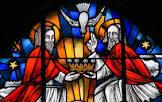
The doctrine of the Trinity was only clearly defined at the Councils of Nicaea in 325 and Constantinople in 381. Though references are made in both the Old and New Testaments, it sees to have taken time for the mystery of three persons in one God to have been reflected on and eventually accepted as dogma. Obviously this is completely beyond human understanding. However the theologian Justo Gonzalez points out that: “Trinity is a mystery, not a puzzle. Love is a mystery, a crossword is a puzzle. You try to solve the puzzle, you stand in awe before the mystery.”
In “The Shack” by William Paul Young, the three persons of the Trinity are pictured as an Afro-American woman, a middle eastern workman and a fey Asian woman. The story highlights some important aspects of the triune God. Firstly, the three persons are distinct and have separate functions. The Father is the creator and initiator, the Son is his Word made human and the Spirit is the energy that flows from them and that energy is love. Secondly, that love is illustrated by the way in which the characters interact with each other. They invite the hero of the story, Mack, to visit them in an old wooden shack, in order to help him come to terms with the kidnap and murder of his little girl Missy. Perhaps instead of trying to rationalise the Trinity, which is impossible, we should try to experience the working of the three Divine Persons. St Ignatius Loyola was given the privilege of doing this when he imagined the Trinity as three organ keys, in perfect harmony. In his autobiography he relates how he could not stop talking about the intense feeling stirred up within him in the encounter.
We can envisage Father, Son and Holy Spirit engaged in a eternal dance and their invitation for each of us to join in with them.